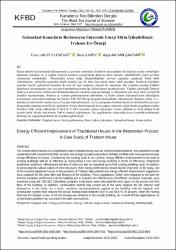| dc.contributor.author | Lakot Alemdağ, Esra | |
| dc.contributor.author | Şahin, Birol | |
| dc.contributor.author | Akkan Çavdar, Ayça | |
| dc.date.accessioned | 2023-10-13T13:33:07Z | |
| dc.date.available | 2023-10-13T13:33:07Z | |
| dc.date.issued | 2023 | en_US |
| dc.identifier.citation | Lakot Alemdağ, E., Şahin, B. & Akkan, A. (2023). Geleneksel Konutların Restorasyon Sürecinde Enerji Etkin İyileştirilmesi: Trabzon Evi Örneği. Karadeniz Fen Bilimleri Dergisi, 13(), 202-222. https://doi.org/10.31466/kfbd.1229963 | en_US |
| dc.identifier.issn | 2564-7377 | |
| dc.identifier.uri | https://doi.org/10.31466/kfbd.1229963 | |
| dc.identifier.uri | https://hdl.handle.net/11436/8498 | |
| dc.description.abstract | İnşaat sektörü küresel enerji kullanımında ve çevresel sorunlarda önemli bir paya sahiptir. Konutlarda enerji verimliliğini
arttıracak önlemler ile iç mekân iklimsel konforu iyileştirilerek daha az enerji tüketen, sürdürülebilir yapılı çevreler
oluşturmak mümkündür. Ülkemizdeki konut stoğu düşünüldüğünde mevcut yapılarda yapılacak enerji etkin
iyileştirmeler, verimlilik açısından düşük enerjili yeni bir bina inşa etmek kadar etkili olacaktır. Kentlerin kimliğini
yansıtan tescilli geleneksel konutlar da mevcut yapı stoğunun önemli bir parçasıdır. Bu yapıların taşıdığı kültürel
değerlerin korunmasının yanı sıra enerji performanslarının da iyileştirilmesi gerekmektedir. Yapılan çalışmada Trabzon
ilinde yer alan restore edilmiş tescilli konutlardan biri seçilerek yapı dış kabuğu ve döşemeleri için enerji etkin iyileştirme
önerileri hazırlanmıştır. Binanın ısı yalıtım performansının arttırılması ve farklı yalıtım malzemelerinin etkinliğinin
incelenmesi amacıyla hazırlanan bu öneriler TSE 825 Hesap programı kullanılarak irdelenmiştir. Binanın zemin ve 1.
katında yer alan her bir mekân için ısı kayıpları hesaplanmıştır. Ayrıca çalışmada önerilen dış duvar alternatifleri için aynı
programda yoğuşma kontrolü de yapılmıştır. Sonuç olarak bağdadi duvar yapım sistemine sahip binada uygulanan yalıtım
önerileri yıllık ısıtma yüklerinde % 66.8 ile % 68.8 arasında azalma sağlamıştır. Isıtma yükünün en fazla olduğu Ocak
ayında örnek binada maksimum %66.4 tasarruf sağlanmıştır. Bu uygulamalar sonucunda duvar konstrüksiyonlarında
herhangi bir yoğuşma problemi de meydana gelmemiştir. | en_US |
| dc.description.abstract | The construction industry has a significant share in global energy use and environmental problems. It is possible to create
sustainable built environments that consume less energy by improving indoor climatic comfort with measures to increase
energy efficiency in houses. Considering the housing stock in our country, energy efficient improvements to be made in
existing buildings will be as effective as constructing a new low-energy building in terms of efficiency. Registered
traditional residences reflecting the identity of cities are also an important part of the existing building stock. In addition
to preserving the cultural values of these structures, their energy performance should also be improved. In the study, one
of the restored registered houses in the province of Trabzon was selected and energy efficient improvement suggestions
were prepared for the outer skin and flooring of the building. These suggestions, which were prepared to increase the
thermal insulation performance of the building and to examine the effectiveness of different insulation materials, were
examined using the TSE 825 Calculation program. Heat losses were calculated for each space on the ground and first
floor of the building. In addition, condensation control was carried out in the same program for the exterior wall
alternatives in the study. As a result, insulation recommendations applied in the building with the bağdadi wall
construction system have reduced the annual heating loads between 66.8 % and 68.8 %. In January, when the heating
load was the highest, a max. of 66.4% savings was achieved in the sample building. As a result of these applications, no
condensation problem has occurred in the wall constructions. | en_US |
| dc.language.iso | tur | en_US |
| dc.publisher | Giresun Üniversitesi | en_US |
| dc.rights | info:eu-repo/semantics/openAccess | en_US |
| dc.subject | Bağdadi duvar | en_US |
| dc.subject | Enerji performansı | en_US |
| dc.subject | Enerji etkin iyileştirme | en_US |
| dc.subject | Geleneksel konut | en_US |
| dc.subject | Isıtma yükleri | en_US |
| dc.subject | Bağdadi wall | en_US |
| dc.subject | Energy performance | en_US |
| dc.subject | Energy efficient improvement | en_US |
| dc.subject | Traditional housing | en_US |
| dc.subject | Heating loads | en_US |
| dc.title | Geleneksel konutların restorasyon sürecinde enerji etkin iyileştirilmesi: Trabzon evi örneği | en_US |
| dc.title.alternative | Energy efficient improvement of traditional houses in the restoration process: A case study of Trabzon house | en_US |
| dc.type | article | en_US |
| dc.contributor.department | RTEÜ, Mühendislik ve Mimarlık Fakültesi, Mimarlık Bölümü | en_US |
| dc.contributor.institutionauthor | Lakot Alemdağ, Esra | |
| dc.contributor.institutionauthor | Şahin, Birol | |
| dc.contributor.institutionauthor | Akkan, Ayça | |
| dc.identifier.doi | 10.31466/kfbd.1229963 | en_US |
| dc.identifier.volume | 13 | en_US |
| dc.identifier.issue | 1 | en_US |
| dc.identifier.startpage | 202 | en_US |
| dc.identifier.endpage | 222 | en_US |
| dc.relation.journal | Karadeniz Fen Bilimleri Dergisi | en_US |
| dc.relation.publicationcategory | Makale - Uluslararası Hakemli Dergi - Kurum Öğretim Elemanı | en_US |


















